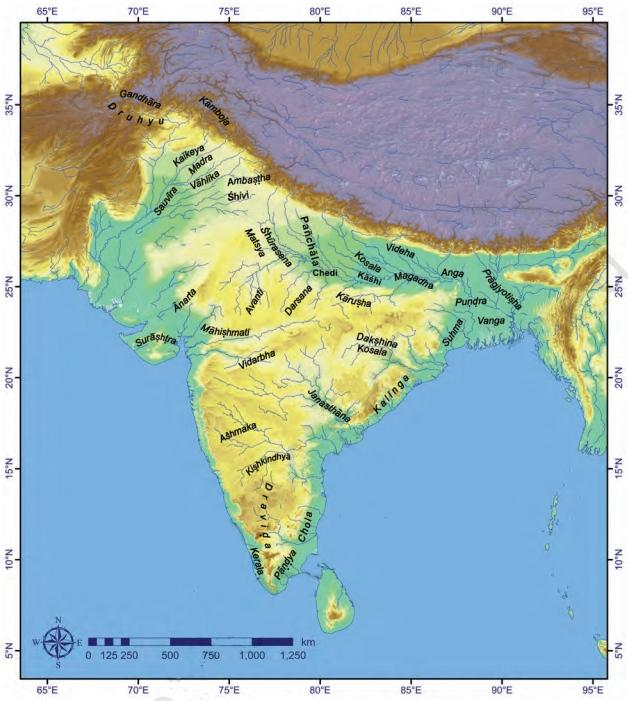What Are The India That Is Bharat Class 6 Questions And Answers For Exam Preparation?
FAQs on NCERT Solutions For Class 6 Social Science Chapter 5 India That Is Bharat
1. NCERT solutions for Class 6 Social Science Chapter 5 PDF
You can access the NCERT Solutions for Class 6 Social Science Chapter 5 in PDF format, which provide stepwise, textbook-aligned answers to all the questions in both History, Geography, and Political Science chapters as per the CBSE 2025–26 NCERT pattern. These PDFs follow the latest syllabus and include accurate, CBSE approved solutions for all exercises and intext questions, making your preparation easy and systematic.
2. How do I get NCERT solutions for Class 6 Social Science Chapter 5 English?
NCERT Solutions for Class 6 Social Science Chapter 5 in English present answers in a clear, easy-to-understand manner, strictly following the CBSE and NCERT guidelines. Each answer uses official textbook language and matches the stepwise format needed for full scoring in school exams. Download links from trusted sources such as Vedantu are suggested for authentic solutions.
3. History Class 6 Chapter 5 question answer
The NCERT Solutions for History Class 6 Chapter 5 ('What Books and Burials Tell Us') provide direct, pointwise answers to every intext and exercise question. All answers explain the context of Vedas and burial practices as discussed in the NCERT book, using the approved CBSE 2025–26 answer structure, ensuring you write in the format expected in exams.
4. Class 6 Social Science Chapter 5 question answer PDF
The question answer PDF for Class 6 Social Science Chapter 5 contains all textbook exercise questions solved in detail, covering History, Geography, and Civics portions as per the NCERT textbook. Each answer follows a stepwise explanation, using simple language and clear points to maximize understanding and scoring, as set by the CBSE-approved answer key format.
5. What is the official NCERT answer for Political Science Class 6 Chapter 5?
The official NCERT answer for Class 6 Political Science Chapter 5 ('Panchayati Raj') strictly follows the CBSE pattern, providing concise and accurate explanations for all exercise and intext questions. Answers use correct terminology for Panchayat system, administration, and CBSE-recommended points so students can score well and understand the NCERT structure.
6. NCERT Geography Class 6 Chapter 5 PDF
NCERT Geography Class 6 Chapter 5 PDF contains solved questions, diagrams, and stepwise answers for 'Major Domains of the Earth' (the focus of Chapter 5). Each solution highlights key terms like lithosphere, hydrosphere, atmosphere, and biosphere, as directed in the 2025–26 NCERT syllabus, ensuring all answers are up-to-date and CBSE approved.
7. How are Class 6 Geography Chapter 5 question answers structured in NCERT solutions?
Class 6 Geography Chapter 5 question answers in NCERT solutions are structured to include clear introductions, bullet points where needed, and textbook-accurate explanations. Each answer follows the NCERT answer pattern, giving precise definitions, examples, and labelled diagrams if required, in alignment with CBSE 2025–26 guidelines.
8. NCERT Class 6 History Chapter 5 PDF
The NCERT Class 6 History Chapter 5 PDF provides stepwise solutions for all intext and end-exercise questions on 'What Books and Burials Tell Us'. Answers include references to important sources like the Rigveda, Megaliths, and archaeological findings, following the latest CBSE-approved format for 2025–26 board preparation.
9. Where can I find the correct stepwise answers for Class 6 Social Science Chapter 5?
The correct stepwise answers for Class 6 Social Science Chapter 5 can be found in updated NCERT Solutions, which break down each question into clear points as per the NCERT textbook. These solutions follow every step required by CBSE, ensuring you present your answers in a way that matches the examiner's expectations and avoids missing marks due to structure errors.
10. Do the NCERT solutions for Class 6 Social Science Chapter 5 include explanations for intext and exercise questions?
Yes, the NCERT solutions for Class 6 Social Science Chapter 5 include thorough, NCERT-pattern explanations for every intext and exercise question, ensuring you understand not only the final answer but the reasoning and steps involved. This helps build conceptual clarity and exam readiness according to the latest CBSE 2025–26 syllabus.
11. How should I present long answers from Social Science Chapter 5 as per CBSE guidelines?
For long answers in Social Science Chapter 5, you should start with a brief introduction, then use stepwise, logically ordered points, and conclude with a summary statement. Always use NCERT textbook terms and ensure diagrams or maps are neatly labelled as instructed. This presentation aligns with CBSE answer standards and maximizes your marks.
12. What can students do if they are confused about textbook terminology in NCERT Class 6 Social Science Chapter 5?
If students are confused about textbook terminology in Chapter 5, they should refer directly to NCERT solutions which clarify terms with simple explanations and contextual examples, ensuring accuracy as per the CBSE 2025–26 syllabus. NCERT solutions use the official language and structure accepted by all CBSE schools nationwide.
13. Are diagrams required for answers in Geography Class 6 Chapter 5 NCERT solutions?
Yes, some questions in Geography Class 6 Chapter 5 benefit from neat, labelled diagrams—such as showing the Earth's major domains. NCERT solutions indicate where to include diagrams and guide students on CBSE-approved presentation methods to gain full marks for diagram-based questions.



























